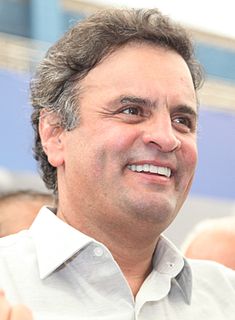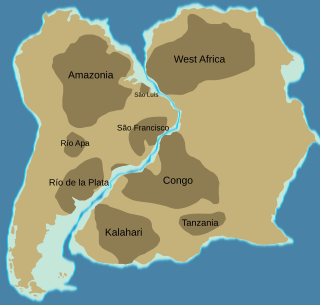Related Research Articles

José Sarney de Araújo Costa is a Brazilian politician, lawyer, and writer who served as 31st President of Brazil from 21 April 1985 to 14 March 1990. At age 91, he is the oldest living former Brazilian president, and, as of the death of João Figueiredo in 1999, the only living former president not to have been elected by direct vote.

Milton Nascimento is a prominent Brazilian singer-songwriter and multi-instrumentalist, known globally as one of the most influential and talented Brazilian musicians. Elis Regina once stated that "if God had a voice, it would be Milton's".

Tancredo de Almeida NevesSFO was a Brazilian politician, lawyer, and entrepreneur. He served as Minister of Justice and Interior Affairs from 1953 to 1954, Prime Minister from 1961 to 1962, Minister of Finance in 1962, and as Governor of Minas Gerais from 1983 to 1984. He was elected President of Brazil in 1985, but died before he took office.

Aécio Neves da Cunha is a Brazilian economist, politician and former president of the Brazilian Social Democracy Party (PSDB). He was the 17th Governor of Minas Gerais from 1 January 2003 to 31 March 2010, and is currently a member of the Brazilian Chamber of Deputies. He lost in the runoff presidential election against Dilma Rousseff in 2014.
Ricardo Rogério de Brito, better known by his nickname Alemão, is a former Brazilian professional footballer who played as a defensive midfielder. His nickname means German in the Portuguese language. A tenacious and physical yet technically gifted player, Alemão was a strong, consistent, hard-working, and versatile midfielder, who excelled in a holding role as either a defensive midfielder or deep-lying playmaker, due to his tactical intelligence, energy, tackling, and his ability to read the game, as well as his capacity to start attacking plays after winning back possession.

The Amazonian Craton is a geologic province located in South America. It occupies a large portion of the central, north and eastern part of the continent. The Guiana Shield and Central Brazil Shield constitutes respectively the northern and southern exhumed parts of the craton. Between the two shields lies the Amazon Rift, a zone of weakness within the craton. Smaller cratons of Precambrian rocks south of the Amazonian Shield are the Río de la Plata Craton and the São Francisco Craton, which lies to the east.

Thiago Neves Augusto, known as Thiago Neves, is a Brazilian footballer who plays as an attacking midfielder for Campeonato Brasileiro club Sport Recife.

The Rio de la Plata Craton (RPC) is a medium-sized continental block found in Uruguay, eastern Argentina and southern Brazil. During its complex and protracted history it interacted with a series other blocks and is therefore considered important for the understanding of the amalgamation of West Gondwana. Two orogenic cycles have been identified in the RPC: a 2000 Ma-old western domain representing the old craton and a 700–500 Ma-old eastern domain assigned to the Brasiliano Cycle. It is one of the five cratons of the South American continent. The other four cratons are: Amazonia, São Francisco, Río Apa and Arequipa–Antofalla.
João Punaro Bley was a Brazilian military and public administrator.

The São Francisco Craton is an ancient craton in the eastern part of South America. The craton crops out in the Brazilian states of Minas Gerais and Bahia.
The Pharusian Ocean is an ancient ocean that existed from 800 to 635 million years ago, between the break-up of the Rodinia supercontinent and the start of formation of the Gondwana supercontinent.

The geology of Uruguay combines areas of Precambrian-aged shield units with a region of volcanic rock erupted during the Cretaceous and copious sedimentary facies the oldest of which date from the Devonian. Big events that have shaped the geology of Uruguay include the Transamazonian orogeny, the breakup of Rodinia and the opening of the South Atlantic.
The Sociedade Brasileira de Geologia is a technical and scientific society that aims brings to bring together Brazilian geologists, to disseminate technical and scientific information, and to participate in national decisions involving the geological sciences.

The Pampean orogeny was an orogeny active in the Cambrian in the western margin of the ancient landmass of Gondwana. The orogen's remains can now be observed in central Argentina, in particular at the Sierras de Córdoba and other parts of the eastern Sierras Pampeanas. It is uncertain if the orogeny involved at some point a continental collision. The Pampean orogen can be considered both part of the larger Terra Australis orogen and of the Brasiliano orogeny. The Pampean orogeny was succeeded by the Famatinian orogeny further west.
Robert John Pankhurst is a British geologist who has contributed to the study of the paleogeography and plate tectonics of South America. He has been a member of the Chilean Academy of Science since 2004.

Brasiliano orogeny or Brasiliano cycle refers to a series of orogenies of Neoproterozoic age exposed chiefly in Brazil but also in other parts of South America. The Brasiliano orogeny is a regional name for the larger Pan-African/Brasiliano orogeny that extended not only in South America but across most of Gondwana. In a wide sense the Brasiliano orogeny includes also the Pampean orogeny. Almeida et al. coined the term Brasiliano Orogenic Cycle in 1973. The orogeny led to the closure of several oceans and aulacogens including the Adamastor Ocean, the Goianides Ocean, the Puncoviscana Ocean and the Peri-Franciscano Ocean.
The Cariri Velhos belt is a belt of rocks in Brazil that were deformed and metamorphosed in the Early Neoproterozoic. The belt runs from the Atlantic more than 700 kilometres (430 mi) inland in a SWW direction. The width of the belt varies from 100 to 50 kilometres.
The Paranapanema block is a coherent block of lithosphere located in southeastern South America spanning roughly the same area as the Paraná Basin. The existence of a tectonically stable zone beneath the Paraná Basin was first suggested in 1975. Despite difficulties in accessing the buried Paranapanema block it is inferred it must be composed mostly of orthogneiss and that it existed before the Brasiliano orogeny.

The Cathedral Basilica of Our Lady of the Snows also called João Pessoa Cathedral is a Catholic church located in the old town of João Pessoa, capital of the state of Paraiba in Brazil. It is the seat of the Archdiocese of Paraíba.

The Parnaíba Basin is a large cratonic sedimentary basin located in the North and Northeast portion of Brazil. About 50% of its areal distribution occurs in the state of Maranhão, and the other 50% occurring in the state of Pará, Piauí, Tocantins, and Cearâ. It is one of the largest Paleozoic basins in the South American Platform. The basin has a roughly ellipsoidal shape, occupies over 600,000 km2, and is composed of ~3.4 km of mainly Paleozoic sedimentary rock that overlies localized rifts.
References
- ↑ Benjamin Bley de Brito Neves Archived 2016-01-27 at the Wayback Machine , Academia Brasilera de Ciências.